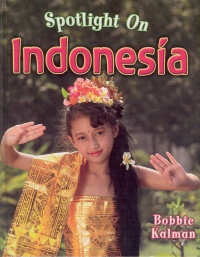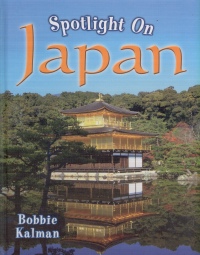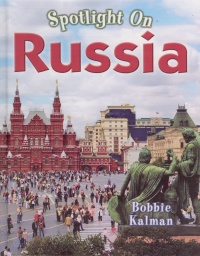| ________________
CM . . . . Volume XVII Number 14. . . .December 3, 2010. 
 |
Spotlight on Egypt. (Spotlight on My Country).
Bobbie Kalman.
St. Catharines, ON: Crabtree, 2011.
32 pp., pbk. & hc., $9.95 (pbk.), $20.76 (RLB.).
ISBN 978-0-7787-3483-3 (pbk.), ISBN 978-0-7787-3457-4 (RLB.).
Subject Heading:
Egypt-Juvenile literature.
Grades 2-4 / Ages 7-9.
Review by Gail Hamilton.
**½/4
|
| |
|
 |
Spotlight on Indonesia. (Spotlight on My Country).
Bobbie Kalman.
St. Catharines, ON: Crabtree, 2011.
32 pp., pbk. & hc., $9.95 (pbk.), $20.76 (RLB.).
ISBN 978-0-7787-3484-0 (pbk.), ISBN 978-0-7787-3458-1 (RLB.).
Subject Heading:
Indonesia-Juvenile literature.
Grades 2-4 / Ages 7-9.
Review by Gail Hamilton.
**½/4
|
| |
|
 |
Spotlight on Japan. (Spotlight on My Country).
Bobbie Kalman.
St. Catharines, ON: Crabtree, 2011.
32 pp., pbk. & hc., $9.95 (pbk.), $20.76 (RLB.).
ISBN 978-0-7787-3485-7 (pbk.), ISBN 978-0-7787-3459-8 (RLB.).
Subject Heading:
Japan-Juvenile literature.
Grades 2-4 / Ages 7-9.
Review by Gail Hamilton.
**½/4
|
| |
|
 |
Spotlight on Russia. (Spotlight on My Country).
Bobbie Kalman.
St. Catharines, ON: Crabtree, 2011.
32 pp., pbk. & hc., $9.95 (pbk.), $20.76 (RLB.).
ISBN 978-0-7787-3486-4 (pbk.), ISBN 978-0-7787-3460-4 (RLB.).
Subject Heading:
Russia (Federation)-Juvenile literature.
Grades 2-4 / Ages 7-9.
Review by Gail Hamilton.
**½/4
|
| |
|

excerpt:
Krakatau is the name of an island. It is also the name of the island’s volcano. Krakatau has erupted many times, but in 1883, it killed thousands of people and filled all of Earth’s atmosphere with volcanic dust.
The Kawah Ijeh volcano in East Java is an active volcano. People are using the gases that escape from the volcano to earn a living. Miners use pipes to turn the gases into hot liquid sulfur, which then dries into hard yellow sulfur. The sulfur is used to make rubber and bleach for sugar. It is also used to make cosmetics, or makeup. Working near this gas is very dangerous to people’s health. (From Spotlight on Indonesia.)
To date, 11 titles comprise the “Spotlight on My Country” series and provide a very general overview of the featured country. Topics include the geography, people, plants and animals, major cities, government, history, culture and food. The large text is enhanced by abundant colour photographs and a few maps as well as a border, consisting of symbols suited to the featured country, running across the top of the page. Each title has 14 chapters. The main text is very general and often omits important information. For example, in the title on Indonesia, the author states, “There are two seasons in Indonesia- the dry season and the wet season. During the wet season, a lot of rain falls.” This is stating the obvious, but lacking in details. In fact, most titles explain very little about a country’s climate. Usually, the labelling beneath the photographs provides more specific information. Sometimes, however, the labelling leaves a lot to be desired, and the reader is left with more questions than answers. A table of contents, a glossary and an index are provided. What can be confusing to young readers who are just learning to use a glossary is the fact that all words printed in boldface type are not necessarily found in the glossary. Some of the words are explained on the same page as they appear.
Spotlight on Egypt takes readers on a mini-tour of Egypt’s ancient history, with information about gods and goddesses, hieroglyphs, pyramids and mummies. Cairo is the featured city. As well, there are facts about desert life, the importance of the Nile River to Egyptians, the various groups that make up Egypt’s population, and the main religion. Several questions remain unanswered after reading this book: why do Muslim girls cover their heads when they read the Qur’an? Why is Cairo called the “Mother of the World?” and why is the lotus an important symbol to Egyptians? Of all the reviewed titles, this one is the most lacking in detail. The last two pages of the book are devoted to examples of photos that a young tourist might take while on a trip to Egypt and the author asks, for instance, “Would you take a picture of some new friends you met in Egypt?” These two pages could have been put to better use, perhaps providing more information about Egyptian culture for that section of the book is very sparse.
Lying between the Indian and the Pacific Oceans is the Indonesian Archipelago, consisting of 6,000 islands. Among other topics, Spotlight on Indonesia describes the area’s coral reefs, the Ring of Fire (which has more active volcanoes than any other place on Earth), the crops grown by farmers, endangered animals, and the influence of the various religious groups- Muslim, Buddhist and Hindu- on the country’s culture. Readers will be surprised to learn that Indonesia has the fourth largest population in the world and the largest Muslim population of any nation.
Japan is an example of a country in which old traditions and the modern way of life co-exist. Spotlight on Japan focuses on Japan’s early history, religions, major cities, foods, the contrast between old art forms and new, such as manga and anime, and celebrations, such as the Doll Festival and Children’s Day. Also included is an explanation of the peace monument, inspired by the story of Sadako and the paper cranes. One photograph in this title is rather strange. It depicts a large family, each member of which is making a heart-shaped form with their fingers. The caption above the photo explains that “this extended family shows their love by making hearts with their fingers.” Though the main body of the text refers to the respect that children have for their elders and the fact that several generations often live under one roof, the inclusion of this particular photo is questionable. Surely there are better examples.
Spotlight on Russia highlights the largest country in the world and its diverse population. Topics in this title include the three main biomes and the animals that inhabit them, city versus country life, art, and Russia then and now, which briefly explains the influence of the czars and communist leaders on the history of the country. This title is missing some facts. For example, in the section devoted to country life and farming, only two types of produce are mentioned, and in the section about culture, the author states that “the Russian calendar is filled with holidays and celebrations,” yet only one holiday is mentioned.
I Have Feelings (Level B) has many of the features required to consider it a Level B text. There is predictable language throughout, and the text includes a word pattern to prompt readers. The topic is also familiar for most children. However, the number of lines of print/page is not consistent, nor is text placement. Once again, the photos that are used as illustrations create good associations for the reader; however, the “angry” picture looks more like smirking! Finally, on pages 12 and 13, the author writes, “I like these feelings. I do not like these feelings.” As a parent and educator, I would prefer to see that children are encouraged to know that all feelings are okay and that sometimes feeling uncomfortable helps us become stronger in character and self. Once again, scaffolding will be needed to read and engage with the latter pages of this text, especially when picture support on these pages doesn’t clearly show the feelings listed.
The next sets of books were considered as Level G texts. Throughout these texts, I would suggest that the “Words to Know” title now state “Glossary” and that a true index be included in this group to better match the criteria of LG. All of the texts at this level present topics that will invite many great dialogues about community. Readers at this stage are learning how to use different text features to build their comprehension skills, in addition to the ongoing consolidation of strategic reading behaviours.
What could have been a very good series is marred by gaps in information and a lack of details. Students who require more specific information for a project about one of these countries will have to find it elsewhere.
Recommended with Reservations.
Gail Hamilton is a retired teacher-librarian in Winnipeg, MB.

To comment on this title or this review, send mail to
cm@umanitoba.ca.
Copyright © the Manitoba Library Association. Reproduction for personal use is permitted only if this copyright notice is maintained. Any other reproduction is prohibited without permission.
NEXT REVIEW |
TABLE OF CONTENTS FOR THIS ISSUE- December 3, 2010.
AUTHORS |
TITLES |
MEDIA REVIEWS |
PROFILES |
BACK ISSUES |
SEARCH |
CMARCHIVE |
HOME |



